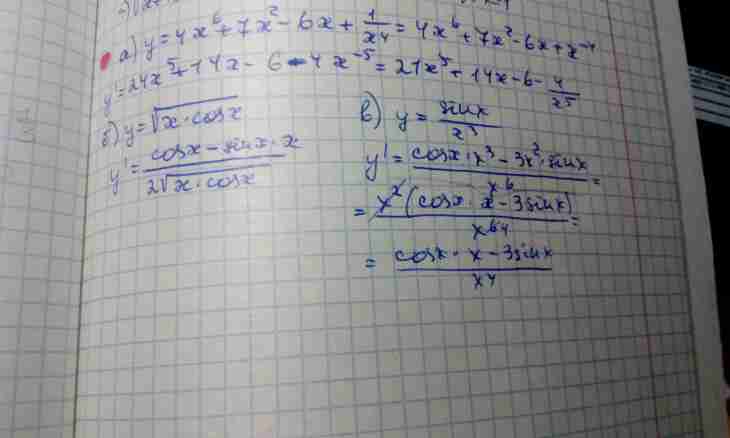Methods of differential calculus are used at a research of nature of behavior of function in the mathematical analysis. However it is not the only sphere of their application, often it is required to find a derivative to calculate extreme sizes in economy, to calculate the speed or acceleration in physics.
Instruction
1. The function derivative in a point shows speed of its change and is calculated through the theory of limits. Therefore it can have both final, and infinite value. In the second case say that initial function is not differentiated in this point. There are rules by which it is possible to find a derivative of the simplest, elementary and difficult function.
2. Remember the table of calculation derivatives protozoa and some elementary functions: - With’ = 0; - x’ = 1; - (C·x)’ = With • x’ = With; - (sin x)’ = cos x; (cos x)’ = - sin x; - (tv x)’ = 1/cos² x; (ctv x)’ = - 1/sin² x; - b^х = b^х • ln b; - lov_b x = 1 / (x • ln b).
3. Apply the general rules of differentiation. A derivative of a power function of a look х^n where n> 1, n·x^ (n-1) is equal. Examples: (х^4)’ = 4 • x³; (5 · x³)’ = 5•3 • x² = 15 • x².
4. The derivative of the sum of functions is by addition of their separate derivatives: (Σfi (x))’ = Σfi’ (x). Examples: (sin x + cos x)’ = cos x – sin x; (х^5 + 6·x^4 – 2 • x² + 14·x)’ = 5·x^4 + 24 • x³ – 4 • x + 14. At differentiation of a polynomial its degree decreases by 1.
5. The work derivative where both multipliers are functions, is equal to the sum of two elements. In the first case it is a derivative of the first function and initial expression of the second, in the second case – on the contrary: (f•v)’ = f’ • v + f · v .Primer: (5^x·lov_5 x)’ = (5^х)’ • lov_5 x + 5^х • (lov_5 x)’ = 5 • x • ln 5 • lov_5 x + 5^х / (x • ln 5).
6. Fraction where the numerator and a denominator – functions, is differentiated on more difficult formula: (f/v)’ = (f’ • v-f • v’) / v². Example: ((x • sin x) / (5 • x² + 3)) .Resheniye. Two rules of differentiation are applicable to this expression at once: sums and performing functions of the same argument: ((x • sin x) / (5 • x² + 3))’ = ((x • sin x)’ • (5 · x² + 3) – x • sin x • (5 · x² + 3)’) / (5 • x² + 3)² = ((sin x + x • cos x) • (5 · x² + 3) – x • sin x • 10 · x) / (5 · x² + 3)².
7. Remove the brackets and give similar: x • cos x – x • sin x • (5 · x - 3) / (5 • x² + 3)².
8. To find a derivative of difficult function of a type of f (v (x)), differentiate the senior function f, having taken v for a simple argument. Then increase result by derivative v’ (x). For example: (tv (2 • x² + 3))’ = (tv x)’ • (2 · x² + 3)’ = 1/cos² (2 • x² + 3) • 4 · x = 4 • x / соs² (2 • x² + 3).

